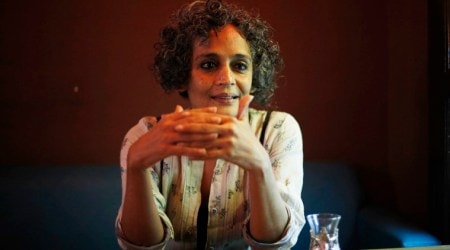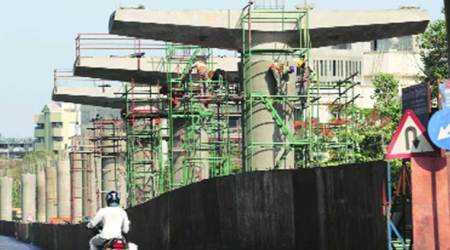 Museum of memories: The Titanic Belfast museum is spread across 12,000 sq m and gives visitors a lowdown on the mammoth ship’s history. (Source: Northern Ireland Tourism Board)
Museum of memories: The Titanic Belfast museum is spread across 12,000 sq m and gives visitors a lowdown on the mammoth ship’s history. (Source: Northern Ireland Tourism Board)
It’s 7 am but I am already behind schedule. I have a train to catch from Dublin Connolly station at 7.35 and nothing’s going like clockwork. I race out of the hotel and flag down a cab. At 7.10 am I am already gasping for air. “You know Chakravarty?” This comes from the front seat. What my Ukrainian cabbie really wants to enquire after is actor Mithun Chakraborty. “Jimmy Jimmy Jimmy, aaja, it’s my favourite,” he says, with a grin. “Of course I know of him, but he’s hung up his dancing shoes a long time ago,” I grin back. Soon, our conversation eats up the miles between downtown Dublin and Connolly. Before I know it, I’m nursing a cup of coffee in the well-appointed waiting room for Belfast-bound passengers.
On the nearly two-hour train commute between Dublin and Belfast, I stamp my memory with pastoral landscapes that fly past the window. Hours later, the bucolic scenes make way for the glistening roads of Belfast, Northern Ireland’s capital, which comes alive with pubs, powerful street art and eye-popping museums. But things weren’t as buzzing a few years ago. Even today, it’s difficult to erase Belfast’s turbulent history and the city is still scarred by violence that lasted more than three decades.
Beginning in the late 1960s, fighting raged between Protestant Unionists, who were in favour of Northern Ireland staying with the United Kingdom and Catholic Nationalists who were keen on the country reuniting with the Irish Republic. Not surprisingly, this period of intense conflict, which stretched right till 1998, has been identified in public discourse as “the Troubles.” And, like many new wave tourists who are irresistibly drawn to Troubles-related locations, I walk around the Great Victoria Street neighbourhood for a closer view of Europa Hotel, which has gained sobriquets like “most bombed hotel in Europe” and “most bombed hotel in the world.” Twelve floors of Europa were hit hard by IRA (Irish Republican Army) bomb attacks more than 30 times during Northern Ireland’s strife-torn era.
But Belfast is also trying to emerge from the sombre shadows of its past, as a destination of hip hotels, raving pub scenes and effervescent restaurants. Directly across the Europa is The Crown Liquor Saloon, one of the most iconic pubs in Northern Ireland. I make my way through it’s iron gates, the filigreed detailing transporting me to another era. During a refurbishment in 1885, Italian craftsmen toiled relentlessly to give shape to the pub’s beautiful interiors — cosy booths once designated for Victorian era patrons and stained glass windows etched with delicate motifs of pineapples, fairies, clowns and fleurs-de-lis.
 (Source: Northern Ireland Tourism Board)
(Source: Northern Ireland Tourism Board)
While vintage pubs give Belfast its character, scores of modern, artisanal bars, local breweries and distilleries, spread across its street art-splashed alleys, give its drinking scene the real buzz. For many connoisseurs, Belfast is the Vatican of all things alcoholic. Beer is the city’s cultural signature, but there are other superbly crafted spirits by regional producers as well. Cathedral Quarter has a range of pubs devoted to craft beers, hoppy ales, traditional ciders and single-estate gins. But, I’m also drawn to the smells of butter-laced champ, the distinctly Irish pub grub that’s taken mashed potato and spring onions to the next level.
Of all star attractions in the city, the Titanic Belfast, a relatively new museum, is a very prominent one — Belfast happens to be the birthplace of RMS Titanic, the most talked-about ocean behemoth in maritime history. Not expected to downplay this historic connection, Belfast erected this massive 12,000 sq m museum in 2012. Inside Titanic Belfast, I too travel back in time, wandering through its interpretative galleries that provide clues on dreams and perceptions around the “unsinkable ship”. While there are showcases of Titanic’s Ritz hotel-inspired interiors (facilities included a gym, pool, Turkish bath, squash court), nuggets of information including its extravagant fuel consumption patterns — the ship guzzled a massive 600 tonnes of coal daily — are revealed as well.
The sixth gallery is, perhaps, the most poignant. Here, the sinking of the liner is conveyed through gut-wrenching images, set against the background score of Morse code SOS messages sent out to neighbouring ships.
But, the port city’s ship-building culture, which reached its acme with the construction of the Titanic, is long gone. Newer industries and sub cultures have taken over even as the nation pulls out all stops to welcome tourists. St George’s Market, the new face of Belfast’s blossoming food and culture scene was built between 1890 and 1896. It was named UK’s Best Large Indoor Market 2014 by the National Association of British Market Authorities, and it has tapped into the global enthusiasm for local and specialty foods. On all sides of the market, there are produce and confection stalls where I drown under gourmand pleasures: from sharp cider made from Bramley apples and crisp bundles of rhubarb to white chocolate fudge buns and cooked crab claws.
It is my last day at Belfast and the city continues to surprise. How is it reinventing itself at such a fast clip? How has it managed to come up with fresh and original tourist haunts despite being new to the scene? My epiphany comes as I scroll down my digital stack of photographs, amassed over the duration of my stay in Northern Ireland. Behind the city’s regeneration are its people, with crazy accents and a riotous sense of humour, who are willing to rediscover and share their cultural past with the rest of the world. And of course, the beer!
The Original Sin: Chocolate!
Independent chocolate brands like Co Couture, in Belfast’s Chichester Street really stand out. A tiny basement establishment, Co Couture is helmed by award-winning local chocolatier Deirdre McCanny who has taken the bean-to-bar experience to the next level. The chocolate boutique offers delectable small-batch hand-made chocolate confections crafted from beans sourced from Madagascar. Try the hot chocolate served with a tiny jug of cream, truffles with ganache fillings and decadent brownies. You’re welcome!

